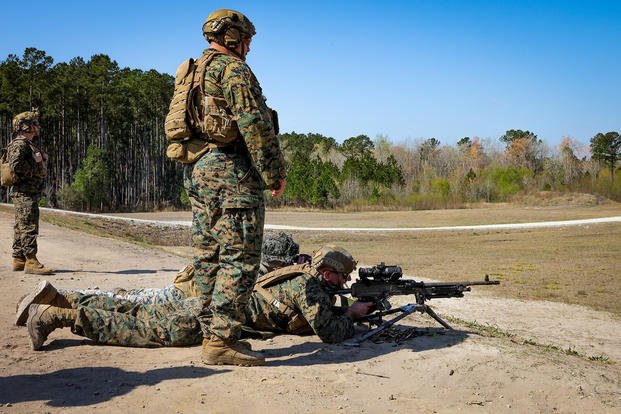North Carolina
Marine Corps Says It’s Investigating Shower Facility Mold at North Carolina Base Following Video Posted Online

After a video was posted online appearing to depict a moldy shower facility, the Marine Corps said that it shuttered the building at Camp Geiger, North Carolina, and sent in health professionals to test for hazards, according to a service spokesperson on Monday.
Last week, an Instagram page called “notinregz” posted a video of Marines walking around a shower facility that appeared to have dark splotches of mold growth on the ceiling of the building.
The Marine Corps spokesperson said that the building contained a faulty air conditioning system, which may have contributed to the apparent growth, and that Marines have been provided alternative facilities to use.
Read Next: A Gigantic New ICBM Will Take US Nuclear Missiles Out of the Cold War-Era But Add 21st-Century Risks
The building belongs to the School of Infantry-East aboard Camp Lejeune, which is one of two infantry schools within the Marine Corps. (To see a video of the mold, click here.)
“[The School of Infantry] has been continuously monitoring their buildings,” Maj. Josh Pena, a spokesperson for the service’s Training and Education Command, told Military.com on Monday, “But they’re aware that the buildings — it’s time for them to be refurbished.”
When asked if Marines were using it prior to last week, when the video was posted, Pena said, “Apparently they were, so what the school has done in response [is] they sent in health professionals to test everything, to see what’s going on.”
The recent discovery of what appeared to be mold at the facility follows concerns about living conditions for troops across the services.
In September, the Government Accountability Office released a report that outlined squalid living conditions that many troops experience, to include stagnant water, bug infestations, squatters and broken, mold-propagating air conditioning — conditions that service members described as “continuous misery” to investigators.
The report found that as of March, 17,000 Marines lived in substandard housing. That is compared to about 5,000 sailors, though investigators noted that the other services did not have standardized tracking requirements, so data was unavailable for the Army and Air Force.
The Army specifically has received intense criticism for its living conditions, which have also included soldiers struggling with mold infestations.
Camp Lejeune and Camp Geiger were not among the Marine Corps facilities that the GAO investigators visited. Air conditioning and HVAC systems generally are important for preventing mold problems, especially in warmer climates such as those in the South.
Pena, the spokesperson, said that the shower facility is currently on the list for refurbishment next year and that it has been closed pending testing and repairs. He also said that the health treatment of the building is ongoing to make sure “that anything that was going in there wasn’t dangerous.”
“The School of Infantry, the command itself, is inspecting every single building, checking all of the AC units,” Pena said. “There are buildings that are going to be getting full refurbishment this next year and that facility in the video is one of them.”
The commandant and sergeant major of the Marine Corps visited Camp Lejeune, which includes Camp Geiger, in October to see the installation’s barracks and facilities themselves.
That same week, Gen. Eric Smith, the commandant, said that fixing the barracks is a “10-year problem.”
“The fact that we’re still living in these barracks, we’re not helping our cause,” Smith said to Marines during the trip, which was later posted in a video on social media. “So, Sgt. Maj. [Carlos Ruiz] and I [are] working with members of Congress you see here and [the secretary of the Navy] to double the amount of money.”
Smith and his senior enlisted counterpart were accompanied by Navy Secretary Carlos Del Toro and Rep. Greg Pence, R-Ind., a Marine Corps veteran, and Rep. Greg Murphy, R-N.C.
“The inspecting of the buildings has been ongoing for a while,” Pena said of Camp Geiger. “They have been going through checking — with the whole initiative on the refurbishment of housing facilities for Marines, the whole barracks initiative across the DoD. So, that has not stopped.”
Marine Corps Barracks Issues Will Likely Take a Decade to Fix, But Work Is Underway, Commandant Says
Story Continues

North Carolina
Tropical Storm Debby: ‘Historic,’ ‘catastrophic’ flooding possible on South Carolina coast

Tropical Storm Debby closing in on Florida, hurricane warnings issued
Strong winds and rain batter coastal Florida as Tropical Storm Debby intensifies
Tropical Storm Debby, in the Gulf of Mexico Sunday afternoon and headed toward the Big Bend area of Florida, is forecast to impact parts of South Carolina and North Carolina this week. Alerts have been issued for the storm that could bring potentially historic rainfall, rough surf and flooding to these regions.
At 2 p.m. Sunday, the National Hurricane Center issued an advisory for Tropical Storm Debby, noting that it is expected to strengthen into a hurricane before making landfall Monday morning. Debby is expected to move slowly across northern Florida and into southern Georgia before moving into the Atlantic Ocean and up the coast.
The cone that shows the storm’s probable path includes much of S.C. However, many variables remain, including the strength of the still-developing storm and its exact eventual path.
Track Tropical Storm Debby
Track Debby: South Carolina Storm Tracker and Model Mixer
What can we expect in South Carolina?
The Hurricane Center’s forecast shows the center of the storm reaching South Carolina by about 8 p.m. Tuesday. But effects like heavy rain could start as early as Monday night.
Rainfall along the coast is expected to be the main concern. The S.C. coast from the southern part of the state past the Charleston area could see 16-20 inches of rain, with local amounts of up to 30 inches. That will likely result in “considerable” flash and urban flooding, and some river flooding is possible, the Hurricane Center said.
“Heavy rainfall will likely result in considerable flooding impacts from the Florida Big Bend region through southeast Georgia and the Coastal Plain of the Carolinas through Friday,” the Hurricane Center said. “Potentially historic heavy rainfall across southeast Georgia and South Carolina through Friday morning may result in areas of catastrophic flooding. Significant river flooding is also expected.”
The likelihood of storm surges creates a life-threatening situation, the Hurricane Center said. Persons located within these areas should take all necessary actions to protect life and property from rising water and the potential for other dangerous conditions. Promptly follow evacuation and other instructions from local officials.
Rain of about 1-4 inches is forecast for parts of the Upstate.
What watches and warnings are in effect in South Carolina?
A flood watch is in effect from 2 a.m. Monday through Friday morning for southeast South Carolina, including Allendale, Beaufort, Charleston, Coastal Colleton, Coastal Jasper, Dorchester, Hampton, Inland Berkeley, Inland Colleton, Inland Jasper and Tidal Berkeley.
A tropical storm watch is in effect for Charleston, McClellanville and Edisto Island. The forecast calls for winds of 20-30 mph with gusts to 40 mph.
A storm surge watch is in effect beginning Monday afternoon for Charleston, McClellanville and Edisto Island, with a potential of 2-4 feet above ground.
What other watches and warnings are in effect?
As of Sunday afternoon the depression was about 125 miles west-southwest of Tampa, Florida.
- A hurricane warning is in effect for Florida coast from the Suwannee River to the Ochlockonee River.
- A hurricane watch is in effect for the Florida coast west of the Ochlockonee River to Indian Pass * Florida coast south of the Suwannee River to Yankeetown.
- A tropical storm warning is in effect for the Dry Tortugas, the Florida coast south of the Suwannee River to East Cape Sable and the Florida coast west of the Ochlockonee River to Indian Pass.
- A tropical storm watch is in effect for the Florida coast west of Indian Pass to Mexico Beach, and the Georgia and South Carolina coast from the Mouth of the St. Mary’s River to South Santee River South Carolina.
- A storm surge warning is in effect for the Florida coast from the middle of Longboat Key northward to Indian Pass including Tampa Bay.
- A storm surge watch is in effect for the Florida coast from Bonita Beach northward to the middle of Longboat Key, including Charlotte Harbor, and thr Georgia and South Carolina coast from the Mouth of the St. Mary’s River to South Santee River South Carolina.
More: When is first day of fall? SC’s weather forecast by Old Farmer’s Almanac; is it accurate?
More: Heat wave continues, cooling stations open in Spartanburg County. What about Greenville?
Where is Tropical Storm Debby?
Track it: South Carolina Storm Tracker and Model Mixer
Conditions at 2 p.m. Aug. 4:
- Location: 125 miles west-southwest of Tampa, Florida.
- Maximum sustained winds: 65 mph.
- Movement: North-northwest at 13 mph.
More: Heat advisory in effect for Greenville, Spartanburg and Anderson, precautions to stay cool
Are you prepared for a hurricane?
Hurricane season runs from June 1 to Nov. 30. Even if this system won’t pose a threat to the Upstate, it’s never too early to be prepared.
Iris Seaton, Carolinas Connect, and Cheryl McCloud, USA TODAY NETWORK – Florida, contributed.
Todd Runkle is the Carolinas Connect editor and also a content coach for the Asheville Citizen Times, part of the USA TODAY Network. Reach him at trunkle@gannett.com.
North Carolina
North Carolina Zoo celebrates its 50 anniversary

ASHEBORO, N.C. (WTVD) — The North Carolina Zoo is celebrating 50 years.
Located in Asheboro, the zoo houses about 1,700 animals and over 250 species primarily from Africa and North America.
On social media, NC Zoo wrote Friday:
“Throughout our history, we’ve been home to a diverse array of remarkable animals, dedicated keepers, and passionate employees who work tirelessly behind the scenes. Join us in honoring this milestone by visiting the Zoo in 2024!”
The Zoo also mentioned the Zoo’s first animals, which were two Galapagos tortoises named Tort and Retort.
The post said in part: “These two tortoises symbolize the early days of the North Carolina Zoo and are cherished deeply in our hearts.”
The North Carolina Zoo is one of two state-supported zoos in the country. The other is the Minnesota Zoo.
Copyright © 2024 WTVD-TV. All Rights Reserved.
North Carolina
NC has some of the most dangerous roads in the US: See how Wilmington-area counties rank
With a recent study revealing North Carolina as one of the states with the riskiest roads to travel, some may wonder how safe the roads are here in the Cape Fear region.
MarketWatch Guides, a site that provides “reviews of consumer products and services to help readers make educated purchasing decisions,” focuses in part on car insurance comparisons, vehicle safety and more.
A recent study by the site analyzed factors including annual miles driven per 100,000 system miles, percentage of rough roads and fatal injuries per 100,000 licensed drivers. States were given a rating out of 10 points, with 10 being the most dangerous.
More: Distracted driving in Wilmington: How big of a problem is it?
North Carolina’s ranking among the most dangerous
According to the study, the states with the most dangerous drivers based on the factors studied are:
- Louisiana – 7.55/10
- California – 7.21/10
- New Mexico – 6.74/10
- Hawaii – 6.73/10
- Delaware – 6.67/10
- New Jersey – 6.53/10
- Mississippi – 6.47/10
- North Carolina – 6.39/10
- Massachusetts – 6.33/10
- Maryland and Texas – 6.26/10
According to the study, North Carolina had 32.5 fatal injuries per 100,000 licensed drivers, but only 2.1% of rough roads, which was the lowest percentage out of the other ranked states.
For a more localized perspective, the North Carolina Department of Transportation releases annual traffic crash facts data. The most recent 2022 report includes a ranking of counties based on several factors, including reported crashes, crash severity, crash rates based on population, registered vehicles and estimated vehicle miles traveled.
The most dangerous county for drivers, ranked at No. 1 for the past five years, was Robeson County. The county had 60 fatal crashes in 2022 with 1,136 non-fatal injury crashes. The rest of the total 4,056 crashes were property-damage-only. The county with the best ranking was Hyde County, coming in at No. 100. The county had one fatal crash in 2022 and 10 non-fatal injury crashes. The county had a total of 45 crashes, the rest of which were property damage only.
More: MyReporter: Which intersections see the most red-light camera violations in Wilmington?
Here’s where the Cape Fear region counties ranked.
Brunswick County
Ranked No. 76 in 2022, Brunswick County had 25 fatal crashes and 715 non-fatal injury crashes. The total crashes for that year were 3,146. The remainder of the crashes were property damage only.
New Hanover County
Ranked No. 58, New Hanover had 19 fatal crashes and 1,313 non-fatal injury crashes, both of which went down from 2021. The total crashes in New Hanover were 5,617. The remainder of the crashes were property damage only.
Pender County
Ranked No. 47, Pender County had the worst ranking despite having the lowest number of crashes. The county had 12 fatal crashes and 374 non-fatal injury crashes, and a total of 1,156 crashes. The rest of the crashes were property damage only.
Iris Seaton, USA Today Network, contributed to this report.
-

 Mississippi5 days ago
Mississippi5 days agoMSU, Mississippi Academy of Sciences host summer symposium, USDA’s Tucker honored with Presidential Award
-

 Politics1 week ago
Politics1 week agoRepublicans say Schumer must act on voter proof of citizenship bill if Democrat 'really cares about democracy'
-

 Politics1 week ago
Politics1 week agoTrump announces to crowd he 'just took off the last bandage' at faith event after assassination attempt
-
World7 days ago
More right wing with fewer women – a new Parliament compendium
-

 World1 week ago
World1 week agoIsrael says Hezbollah crossed ‘red line’, strikes deep inside Lebanon
-

 Politics1 week ago
Politics1 week agoHarris failed to combat ‘root causes’ of illegal immigration, former Border Patrol union chief says
-

 News1 week ago
News1 week agoVideo: Kamala Harris May Bring Out Trump’s Harshest Instincts
-

 World1 week ago
World1 week agoItaly's Via Appia enters the Unesco World Heritage List






/cdn.vox-cdn.com/uploads/chorus_asset/file/25462010/STK155_OPEN_AI_CVirginia_D.jpg)









